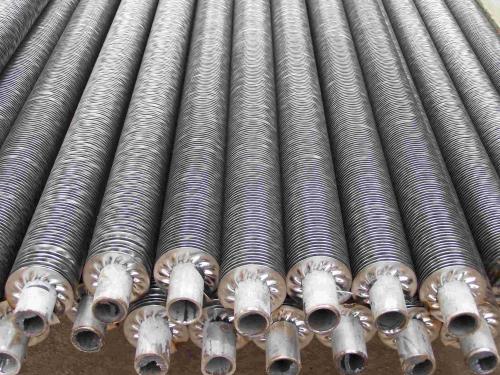Lord Fin Tube--Spiral finned tube
What is spiral finned tube?
Spiral finned tube is used in air conditioning, hot air heating, dehumidification, refrigeration, drying and other heat transfer equipment. It is suitable for heating air by steam or high temperature water (heat-conducting oil) and cooling air by salt water or condensate. The spiral finned tube is a high efficient heat transfer element with spiral fins. The heat transfer area of spiral finned tubes is several to dozens of times that of smooth tubes, which can enhance heat transfer, reduce flow resistance, and reduce metal consumption, thus improving the economy and operation reliability of heat exchange equipment. Spiral Fin coils feature fins of aluminum, copper, stainless steel or carbon steel. The fins are tension wound onto individual tubes to minimize thermal contact resistance and air friction. Tapered fin design provides maximum fin-to-tube contact for optimum heat transfer. Individually finned tubes allow unrestricted movement of the tubes, eliminating stress on the tube and fin to tube bond caused by thermal cycling. Material thicknesses on the fins can range from 0.010” to 0.030” depending on the material being used.
Advantages of Spiral finned tube:
1) Spiral finned tube can increase the heat transfer area and improve the heat transfer effect.
2) Spiral finned tube can reduce the space occupied by the heat transfer, so that the volume is reduced, especially for fast installed boilers.
3) Spiral finned tube can reduce equipment costs, improve equipment safety.
4) The operating cost is reduced due to the lowering of the water side pressure drop.
5) Spiral finned tube can stiffness increases, improve the seismic capacity of the tube and so on.
Manufacturing method of spiral finned tube:
Spiral finned tubes can be manufactured by various methods. Finned tubes used in heat exchange equipment such as boilers and pressure vessels mainly have the following manufacturing methods:
High frequency resistance welding spiral finned tube:
High frequency resistance welding of spiral finned tube is to introduce high power high-frequency current into the weldment, use the resistance heat generated by the current passing through the contact surface of the weldment joint and the adjacent area to make the welding contact surface reach the molten or semi molten plastic state, and then apply appropriate pressure to the welding contact surface to complete the welding of finned tube.
Brazed spiral finned tube:
Brazing spiral finned tubes is to fill a filler metal with a melting point lower than that of the weldment between the weldments, and then heat the brazing temperature. When the weldment is not melted, the filler metal will be wetted and brazed, and the brazed joint will be formed depending on the expansion of the contact part of the weldment, thus completing the welding of spiral finned tubes.
Integral spiral finned tube:
Integral spiral finned tube is a kind of integral spiral finned tube, which is formed by extruding and rolling the tube with thick wall tube (blank tube) under the condition of medium frequency continuous heating.
Spiral finned tube usages:
Spiral finned tubes are extensively utilized in boiler economizers, air preheaters, and the recovery of waste heat in boilers, as well as in heat transfer systems across various industries, including chemicals and pressure vessels. The capacity of these units in boiler applications has expanded from small to large scales, leading to a growing range of applications. In China, numerous specialized manufacturing facilities are capable of producing spiral finned tubes through high-frequency welding and brazing methods. The technology and equipment for finned tube production have evolved through phases of introduction, digestion, absorption, and self-developed design, achieving quality standards that align with advanced international criteria.
Spiral finned tube Testing
The standard coil test involves applying 300 psig of air while submerged in water; however, certain coil types may necessitate different testing conditions. Coils featuring removable headers will undergo hydrostatic testing at 150 psig. For specialized applications, higher design and testing pressures are available.

Spiral finned tube

